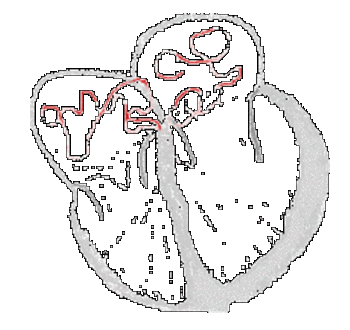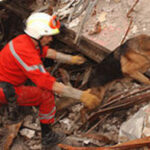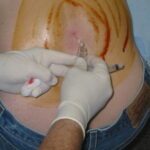The history of TMJ arthroscopy can be traced to the development of the Watanabe No 24 Selfoc arthroscope. In 1970 Ohinishi reported on arthroscopy of the cadever TMJ. Techonological improvements led to the development of the 55 and 70 degree arthroscope. The first report of diagnostic TMJ arthroscopy was performed in 1975. Murakami and colleagues are credited with describing the scientific and clinical considerations of the TMJ arthorscope. Holmlund and Hellsing, using cadaver specimens described the soft tissue landmarks for the location of the puncture site. Hellsing also was the first to describe initial findings such as fibrillation of the temporal cartilage and articular disc4.
However, it was the works of Hopkins and his rod-lens system that revolutionized arthroscopy. The Hopkins rod lens system the roles of glass and air are interchanged so that there are long glass spaces and air lenses. The light transmitting capacity of the endoscope was vastly increased resulting in a brighter image quality, wider viewing angle, and excellent resolution.
TMJ arthroscopy has increased in popularity because it is less invasive than open surgery, is associated with few complications and requires a shorter hospital stay. It is indicated on patients who may have become refractory to conservative treatment and require surgical intervention to relieve TMJ symptoms. The American Association of Oral and Maxillofacial Surgeons outlined the indications for surgical (operative) arthroscopy. Operative arthroscopy was indicated for selected joint conditions that constituted a disability for the patient, that were refractory to medical treatment and that required internal structural modifications1. Upon further review, Israel further established indications to include: 1) the patient has significant pain or dysfunction, producing a disability and poor quality of life. 2) appropriate non-surgical treatment over a reasonable length of time has failed. 3) TMJ is the origin of the pain or dysfunction. 4) there may be possible therapeutic benefit in arthroscopic surgery as a diagnostic modality prior to open joint surgery. 5) any additional myofascial pain symptoms should be under successful management2.
Arthroscopic surgery presents with numerous advantages over invasive open joint surgery. Direct visualization of the anatomic structures in the pathologic tissue with biopsy, removal of osteoarthritic fibrillation tissue as well as injection of a steroid into inflamed synovial tissues can all be accomplished through arthroscopy. Contraindications to arthroscopy are similar to those for other elective procedures such as any medical condition that places the patient at an increased risk from general anesthesia or the surgical procedure itself. Local contraindications include skin or ear infections, possible tumor seating, and severe or advanced fibrous ankylosis resulting in severe limitations and movement of the condyle. Emotional instability, obesity that prevents the joints from being palpated adequately are also considered contraindications.
The most commonly performed TMJ arthroscopic procedures are lysis of adhesions and joint lavage to relieve painful hypomobility. The objective of these techniques are to eliminate restrictions on the disc and lateral capsule, to wash out microscopic debris resulting from the breakdown of the articular surfaces, to irrigate the joint of enzymes and prostaglandins and to stimulate the normal lubricating properties of the synovial membranes3. In order to accomplish this, a blunt trocar or blunt probe is utilized in a sweeping fashion between the disc and temporal bone to accomplish lysis of adhesions.
Another commonly performed arthroscopic procedure is diagnostic arthroscopy. After proper orientation, the examination is executed in three phases: 1) transverse phase, 2) longitudinal phase and 3) the dynamic transverse phase. The transverse phase examines the glenoid fossa and describes the fossa in terms of shape, color, orientation, joint space configuration, and topographical relationship. The second phase of the examination parallels the sagittal axis of the superior joint space and is examined according to three fields called the lateral, central and medial fields. If a displaced disc is evident, the longitudinal examination phase allows the operator to confirm the position of the remodeled disk to the condyle, identify the junction of the remodeled tissue and verify the disc integrity. In the third phase, the assistant gently moves the mandible back and forth while the scope is held still. By doing this an impression may be obtained of where the superior surface of the condyle contacts the disc4. Once the examination has been completed, the remaining fluid in the superior joint space is suctioned and corticosteroids may be injected. Healing is generally unremarkable.
The success of arthroscopic surgery has been documented throughout the literature. Murakami et al. submitted a survey to 37 patients who had been treated with arthroscopic surgery for TMJ internal derangement from 1986 to 1990. All patients rated their pain level on a visual analogue scale, and also recorded pain, jaw dysfunction, and activities of daily living (ADL) before surgery, and at the time of the survey. Intensity of pain as rated on the VAS was significantly reduced from 5.15 to 0.34. Pain, dysfunction and ADL scores also decreased from 8.25 to 1.09, 6.5 to 1.93, and 9.1 to 1.32, respectively. For the success rate of TMJ surgery 27 were rated as excellent, four as good, and three (including two re-operated patients) as poor. The success rate was 83.8% when three patients who did not respond were included in the data5. Indresano examined one hundred temporomandibular joints. Complications from the procedure were low (4%). Eighty joints (50 patients) received superior compartment sweep and lavage. Patients with anteriorly displaced nonreducing discs (closed lock) had the highest success rate (83%) from this procedure when evaluated 9 to 30 months later6.
There are many modalities of therapy that can be utilized for internal derangement. Although it seems logical that conservative, non-invasive therapy is the ideal therapy, there exists a need for surgical intervention. This holds especially true for those patients who do not respond well to conservative therapy. Arthroscopy offers an option for practitioners to provide minimally invasive surgical therapy which has been proven throughout prior literature and clinical procedures. However, as versatile as arthroscopy is it is limited in its uses. The limited visualization field as well as lack of access limits arthroscopy to minor procedures such as examination, lysis and lavage, and minor disc repositioning procedures. It seems unlikely that arthroscopy can be used for more severe TMJ conditions which would require larger procedures such as condylotomy or complete joint replacement. However, arthroscopy still serves as a very successful, minimally invasive procedure which can be used to treat internal derangements for those patients who are non-responsive to conservative therapy.
Works Cited
- American Association of Oral and Maxillofacial Surgeons: position paper on TMJ arthroscopy 1988 In: Thomas M, Bronstein S, editors. Arthroscopy of the temporomandibular joint. Philadelphia: WB Sauders, 1991. 347-50.
- Israel H. Arthroscopy of the temporomandibular joint. In: Peterson L, Indresano T, Marciani R, Roser S, editors. Principles of oral and maxillofacial surgery. Philadelphia: J.B. Lippincott, 1992 2015-40.
- Nitzan DW. Arthrocentesis for management of severe closed lock of the temporomandibular joint. Oral Maxilllo Surg Clin North Am 1994; 6:245-7.
- Heffez L, Blaustein D. Diagnostic arthroscopy of the temporomandibular joint. Oral Surgery Oral Medicine Oral Pathology 1987; 64 653-70.
- Murakami K, Segami N, Okamoto M, Yamamura I, Takahashi K, Tsuboi Y. Outcome of arthroscopic surgery for internal derangement of the temporomandibular joint: long-term results covering 10 years. J Craniomaxillofac Surg. 2000 Oct;28(5):264-71.
- Indresano AT. Arthroscopic surgery of the temporomandibular joint: report of 64 patients with long-term follow-up. J Oral Maxillofac Surg. 1989 May;47(5):439-41.



